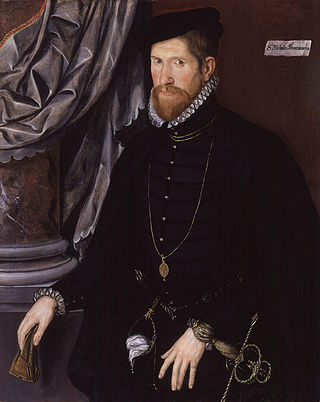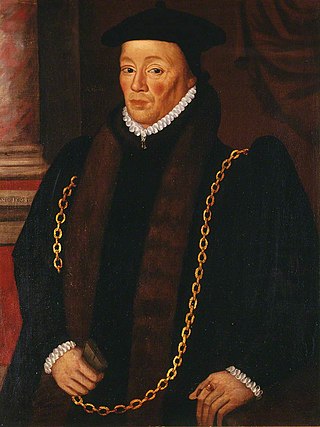Related Research Articles
Edward Sutton, 4th Baron Dudley. The oldest son and heir of John Sutton, 3rd Baron Dudley. He was an English nobleman and soldier. Contemporary sources also refer to him as Sir Edward Dudley.

Sir Nicholas Throckmorton was an English diplomat and politician, who was an ambassador to France and later Scotland, and played a key role in the relationship between Elizabeth I of England and Mary, Queen of Scots.
John Lowe (1553–1586) was an English Catholic priest and martyr.

The Court of the Council in the Dominion and Principality of Wales, and the Marches of the same, commonly called the Council of Wales and the Marches or the Council of the Marches, was a regional administrative body founded in Shrewsbury.
Sir Edward Saunders was an English judge and Chief Justice of the Queen's Bench.
Events from the 1550s in England. This decade marks the beginning of the Elizabethan era.
Events from the 1580s in England.

Thomas Smythe or Smith of London, Ashford and Westenhanger, Kent was the collector of customs duties in London during the Tudor period, and a member of parliament for five English constituencies. His son and namesake, Sir Thomas Smythe, was the first governor of the East India Company, treasurer of the Virginia Company, and an active supporter of the Virginia colony.
Maurice Griffith was a Welshman who became Bishop of Rochester.

Sir William Garrard (1518–1571), also Garrett, Gerrarde, etc., was a Tudor magnate of London, a merchant citizen in the Worshipful Company of Haberdashers, who became alderman, Sheriff (1552–1553) and Lord Mayor of London (1555–1556) and was returned as an MP for the City of London. He was a senior founding officer of the Company of Merchant Adventurers to New Lands in 1554/55, having been involved in its enterprises since the beginnings in King Edward VI's time, and for the last decade of his life was one of its permanent governors. He worked hard and invested largely to expand English overseas trade not only to Russia and the Levant but also to the Barbary Coast and to West Africa and Guinea.

Sir Robert Throckmorton, KG, of Coughton Court in Warwickshire, was a Member of Parliament and a distinguished English courtier. His public career was impeded by remaining a Roman Catholic.
Michael Lok was an English merchant and traveller, and the principal backer of Sir Martin Frobisher's voyages in search of the Northwest Passage. He was the governor of the failed Cathay Company formed with Frobisher in 1577.

George Bromley was an English lawyer, landowner, politician and judge of the Mid-Tudor and Elizabethan period, a member of an important Shropshire legal and landed gentry dynasty. Although his career was overshadowed by that of his brother Thomas Bromley, George Bromley was of considerable importance in the affairs of the Welsh marches and the Inner Temple. He was an MP for Liskeard 1563, Much Wenlock in 1558 and 1559 and Shropshire in 1571 and 1572.
Rose Lok was an English businesswoman and Protestant exile during the Tudor period. At the age of eighty-four, she wrote an account covering the first part of her life.
Sir George Barne was a prominent merchant and public official from London during the reign of Elizabeth I, and the son of Sir George Barne and Alice Brooke.
References
- ↑ Gerhold. London Bridge and its Houses. p. 67.
- ↑ "LOWE, alias FYFIELD, Simon (by 1522-78), of London and Bromley, Kent. - History of Parliament Online". www.historyofparliamentonline.org.
- ↑ Bindoff, S.T., ed., The History of Parliament: The House of Commons 1509 - 1558 (1982). For the family of Simon Lowe see: Lowe family Archived 7 March 2012 at the Wayback Machine
- ↑ The Diary of Henry Machyn, Nicholas J.G. ed., Camden Society Original series 42: London, 1848, p. 180.
- ↑ Thomas F. Mayer and Courtney B. Walters (2008) The Correspondence of Reginald Pole, IV: a Biographical Companion. The British Isles, p.231
- ↑ W. Ogwen Williams in The Dominican Jones & Haworth (eds.)(1957), p. 30
- ↑ Miscellanea XII, Catholic Record Society, p.11: London, 1921. The text reads: "Bromleighe. Mr Simon Lowe of Bromleigh cometh to the churche, but never received the communion, since the Queenes Maiesties Raigne; and is esteemed to be worth in landes 200 markes a yeare, and valued at 300 poundes in goodes."
- ↑ St Magnus Parish Register for February 1577/8. See also Index of wills proved in the Prerogative Court of Canterbury 1558-1583, Smith, S.A. and Duncan, L.L., Vol. III: London, 1898; the entry reads: "1577 Fyfilde als. Lowe, Simon, esquier, Bromley, Kent; St. Magnus the Martir, London; Lincoln; Northants. 13 Langley".
- ↑ Cockayne, G. E., Some account of the Lord Mayors and Sheriffs of the City of London during the first quarter of the seventeenth century, 1601-1625 (London, 1897)
- ↑ Memoirs of Missionary Priests, Vol. I, Challoner, R., 1741-2
- ↑ Anstruther, G., The Seminary Priests: a dictionary of the secular clergy of England and Wales, 1558-1850, Vol. 1, pp. 214-5. See also The Penal Laws: understanding the era of the eighty-five martyrs, article by Patrick Barry in L'Osservatore Romano (Weekly Edition in English), 30 November 1987, p. 8, available at Penal Laws